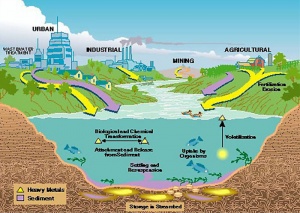Abnormal Development - Heavy Metals
Introduction
The industrialization of the modern world has led to the proliferation in our environment of many different metal compounds. Some metals, such as zinc and iron are required in trace amounts for many biological functions. Other metals such as lead and mercury have had significant toxic effects on development.
There are historic examples of large scale disasters, for example the mercury poisoning of waterways in Japan (More? Mercury) Mercury poisoning (by methyl mercury) or Minamata disease had substantial neurological effects similar to Hunter Russell syndrome.
In addition to their direct toxic effects, the potential reduction in fetal growth and long-term effects should also be considered.
The specific effects of some metals are detailed in Material Safety and Data Sheets (MSDS) available from an chemical index page that relate to developmental abnormalities. These sheets are now generally required to be supplied along with the chemical purchased from a supplier and give a standardised description of the chemical, its physical properties, handling and health effects/toxicity. There are also several internet sites that have searchable databases of MSDS information. Note that handling chemical saftey may vary from country to country.
Some Recent Findings
Metal Toxicity

|
| Heavy Metals Toxicity (Table: U.S. GEOLOGICAL SURVEY CIRCULAR 1133, 1995) |
In another recent study using the sea urchin embryo, Japanese researchers have identified a hierarchy of toxic effects from different heavy metals.
"Interactive toxic effects between heavy metals were investigated using a sea urchin (Anthocidaris crassispina) bioassay. An effluent from an abandoned mine showed significant inhibitory effects on embryo development as well as producing specific malformations. The effects on the embryos were reproduced by synthetic polluted seawater consisting of eight metals (manganese, lead, cadmium, nickel, zinc, chromium, iron, and copper) at the concentrations detected in the mine effluent. This indicated that the heavy metals were responsible for the effects observed. Five heavy metals were ranked in decreasing order of toxicity as follows: Cu > Zn > Pb > Fe > Mn. Among these, zinc and manganese could cause malformation of the embryos. From bioassay results using 27 combinations of heavy metals, 16 combinations including zinc could produce specific malformations, such as radialized, exo-gastrulal, and spaceship Apollo-like gastrulal embryos. Zinc was one of the elements responsible for causing malformations and its effects were intensified by the presence of the other metals, such as manganese, lead, iron, and copper." Naomasa Kobayashia and Hideo Okamurab.
Metal in Water
A major dilemma is the biological difficulty of clearing heavy metals and the subsequent accumulation of these metals in the food chain mainly from the hydrologic environment.
References
Reviews
Articles
Search Pubmed
June 2010 "Maternal Hyperthermia"
Search Pubmed: Maternal Hyperthermia
External Links
Glossary Links
- Glossary: A | B | C | D | E | F | G | H | I | J | K | L | M | N | O | P | Q | R | S | T | U | V | W | X | Y | Z | Numbers | Symbols | Term Link
Cite this page: Hill, M.A. (2024, April 19) Embryology Abnormal Development - Heavy Metals. Retrieved from https://embryology.med.unsw.edu.au/embryology/index.php/Abnormal_Development_-_Heavy_Metals
- © Dr Mark Hill 2024, UNSW Embryology ISBN: 978 0 7334 2609 4 - UNSW CRICOS Provider Code No. 00098G

